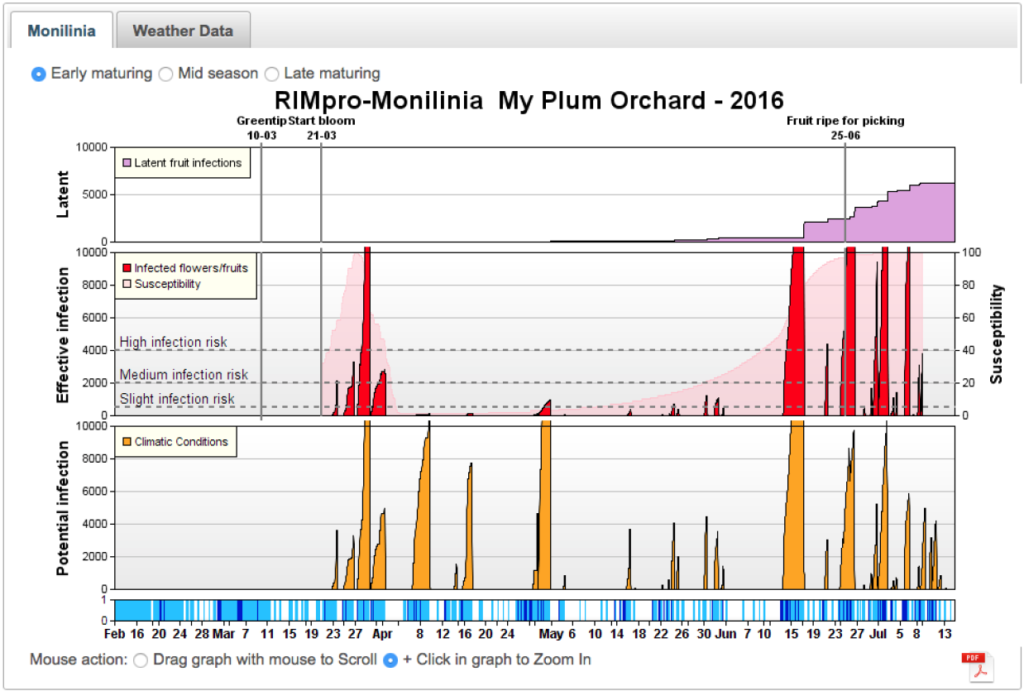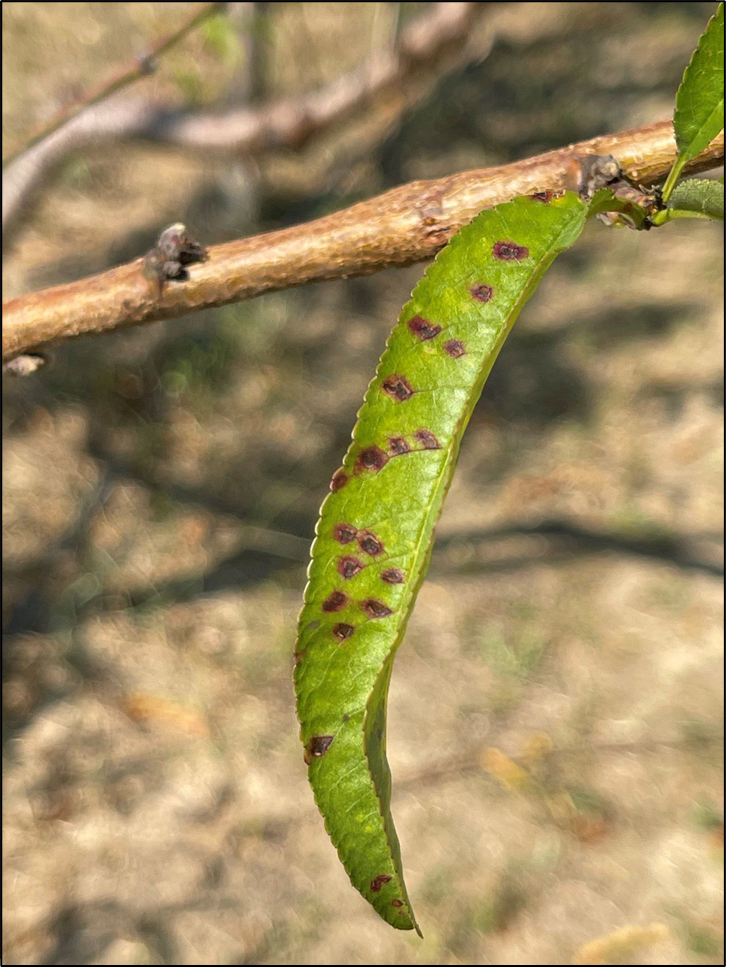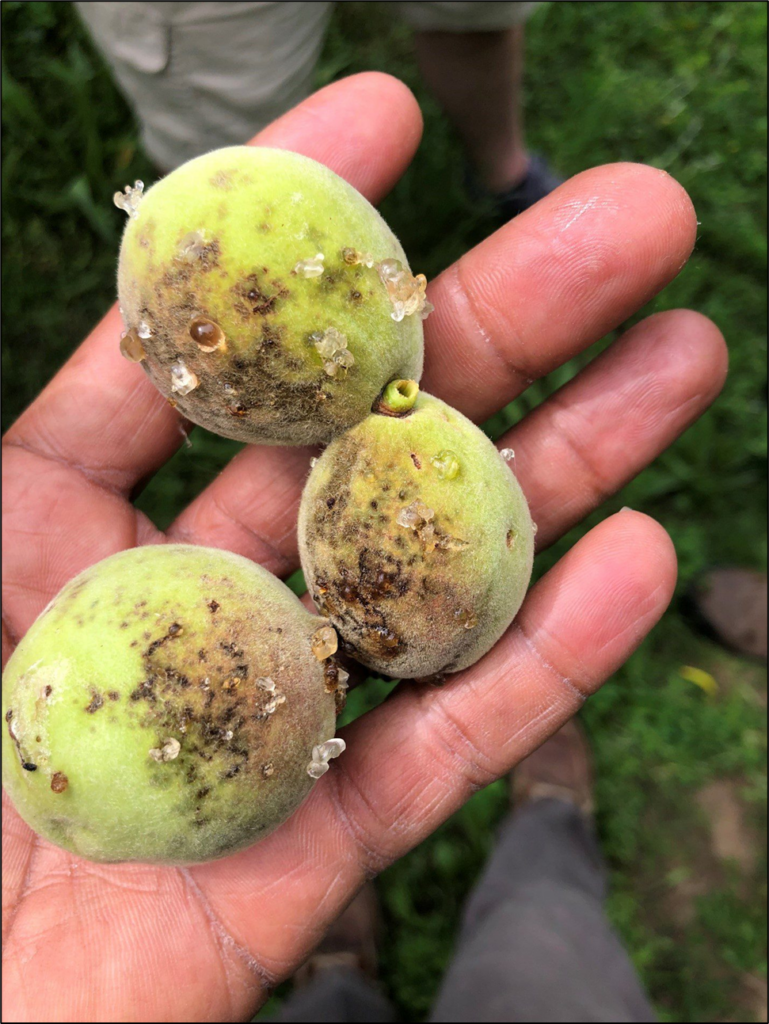Four Main Considerations For Virginia Peach Fungicide and Bactericide Spray Programs in 2024
1. If peach leaf curl was a problem last year: Early in the spring, Ziram should be applied if leaf curl has been a problem last year and you skipped applying it in fall. If would be best applied before bud swell but it can be done also at this stage as well. If you want to use copper for leaf curl instead, it should be applied while trees are dormant and, up to and during bud swell (bud break). Use at least 4 to 8 lb of metallic copper per acre, depending on the label. You can combine Ziram and copper or copper and Bravo (chlorothalonil), but do not apply Ziram and copper during bud swell (bud break). Copper aims to reduce the spores of peach leaf curl fungus Taphrina deformans which overwinter on the tree buds. Infections take place in the spring as the buds open. This fungal pathogen infects buds during rain events from bud swell to bud opening. Very long cool wet periods during bud burst can slow peach bud development and thus lead to severe peach curl infections. Copper products also give some suppression of bacterial spot (Xanthomonas arboricola pv. pruni). Here is more info on that: https://dev-ppa.pantheonsite.io/copper-bactericides-for-peach-bacterial-spot-management/ In spring, if you missed the window for late winter copper application, and you suspect based on cool and wet weather that infection has already occurred, Bravo (or other chlorotahlonil generics, e.g. Initiate) or Ziram are better than copper as they have efficacy after infection and Bravo and its generics redistribute well during rain.
2. Brown rot and rusty spot: We usually do not have issues with brown rot blossom blight in spring in Virginia. That would set you to start applying the first chlorothalonil fungicide for Monilinia, like Initiate, at petal fall. At shuck split you should use Rhyme against for rusty spot. If rusty spot is a concern due to high infection pressure last year, continue applications for it at 1st and 2nd cover using Microthiol Disperss (sulfur) at 10 lbs/A plus Rhyme 7 oz/A or use Captan 4L (4 pints/A) plus Topsin (16 oz/A) at these covers instead, if rusty spot was not an issue. At 3rd and 4th cover use Microthiol Disperss (sulfur) alone at 10 lbs or Captan 4L (4 pints/A) plus Topsin (16 oz/A).
In some parts of Virginia, brown rot fungus was found to be resistant to the benzimidazole fungicide Topsin. Thus use Topsin M in tank-mix combination with other (non-benzimidazole) fungicides. If you experience failure in control there might be fungicide resistance issue and these events of loss in efficacy express in times of high infection pressure fueled by excessive rains and cold weather. If efficacy failures occur, change tactics to apply the highest rates on the fungicide label to achieve complete Monilinia population kill and secure good canopy coverage (spraying on days with winds 8 mph or more is not going to secure good coverage). In such orchards, do not use alternate-row middle spraying.
Coming closer to harvest, brown rot on fruit requires more intense fungicide applications. You would be best off to alternate Merivon 5 oz/A, then switch to Indar 6 oz/A beginning 3 weeks before harvest. If rain becomes prevalent, you can add other fungicides in rotation and start earlier then 3 weeks before harvest.
3. Brown rot options you should consider: RIMpro online cloud-cluster of digital models developed in Europe has brown rot prediction model which can help you decide when to apply your fungicides (Fig. 1). You can find out more information on subscription on:
https://rimpro.cloud/platform/brown-rot-monilinia-spp/
https://blogs.cornell.edu/newa/rimpro-data-feeds/request/
Subscription for one individual grower is ~$270 for one weather station and allows you access to all the apple, stone fruit, and grape disease models but it also includes some insect pest occurrence prediction models (please contact me at acimovic@vt.edu and I can guide you through this process). So far we have five NEWA stations in Virginia connected to RIMpro tree fruit disease prediction models.

Figure 1. Output from Brown Rot prediction model by RIMpro. Weather conditions frequently allow for infection (lower graph), but the real infection risk strongly depends on the inoculum, growth stage (flowering, ripening fruits), and wounding (e.g. hail, insects). Growth stages of many varieties of cherries, plums, nectarines apricots varies, and thus their susceptibility in time also varies. The user must set the estimated local date for flowering and harvest to allow the model to produce accurate predictions. The situation for ‘early’, ‘mid-season’ and ‘late’ varieties (left top corner of the Figure 1 above) is calculated and presented in parallel on the model output. In the example shown the early stone fruit varieties in this orchard are hit by severe infections during bloom resulting in ‘brown rot blossom blight. The following infection events during April and May did not result in infected fruit as the fruit are not yet susceptible (April 5 – June 10). During June, when the fruit are maturing and susceptibility increases, a series of severe infections occurred just before and during harvest. These infections will result in an increase of latent infections that will manifest in the grocery store (Source: RIMpro B.V., Netherlands).
4. Bacterial spot of peach (Figs 2 and 3). If from petal fall to 2-3 weeks after shuck split you expect warm and wet weather (70-85F), the bacterial pathogen Xanthomonas arboricola pv. pruni can cause peach spot of leaves and fruit.


Figure 3. Early growing season bacterial spot infections on peach fruit visible as deep pits or cracks (Photo Credit: Edgar Vinson, Kassie Conner, and Edward Sikora, Alabama A&M and Auburn Universities).
Protection is necessary from petal fall up to 2-3 weeks after shuck split and until pit hardening, if wet conditions continue. Fruit infections take place after shuck split and require protection by alternating sprays of antibiotic oxytetracycline (FireLine, Mycoshield) and low rate copper (however, copper can injure leaves and fruit under slow drying conditions). Keep in mind that oxytetracycline has a very short residual and needs to be applied before rain that will cause main infection pressure for the bacterium. Due to short residual it is merely suppressing the disease and it will not give you perfect control. Many growers find the antibiotic too expensive for their operations and use copper instead, reserving antibiotic use only before heavy infection pressure rains. However, oxytetracycline is the material least prone to causing phytotoxicity on peach and nectarines. Poor timing in delivery of this antibiotic and it’s overuse can lead to loss of it’s efficacy due to acquisition of resistance in the bacterium. There is some evidence that the hydrochloride form of oxytetracycline (Fireline) is more effective than the calcium form Mycoshield. Do not apply either FireLine or Mycoshield on peaches or nectarines during 21 days before harvest. The best control of bacterial spot is planting resistant cultivars (e.g. Biscoe, Blazing Star, Candor, Contender, Harrow Beauty, Harrow Diamond, PF1, PF12A, PF24-007, PF27A, Starfire; source: Shane Bill, 2011). Many other cultivars have fair, moderate to good resistance to this disease, but can get infected severely if weather/site conditions favor this disease and chemical means of protection are not applied on time or as frequently as rain periods dictate.
